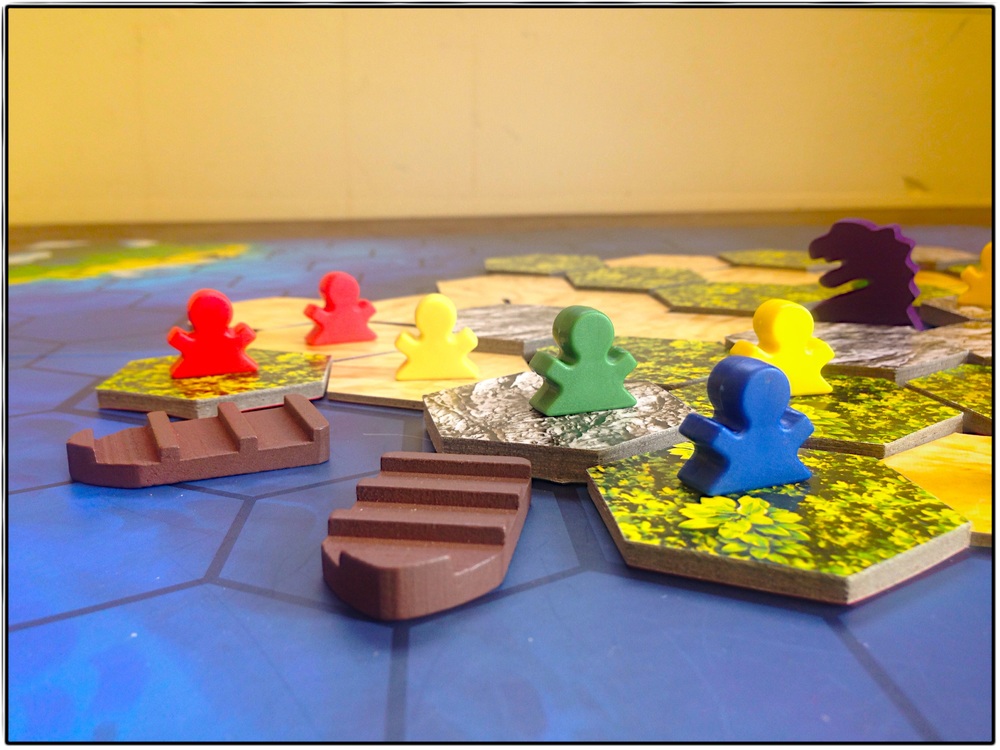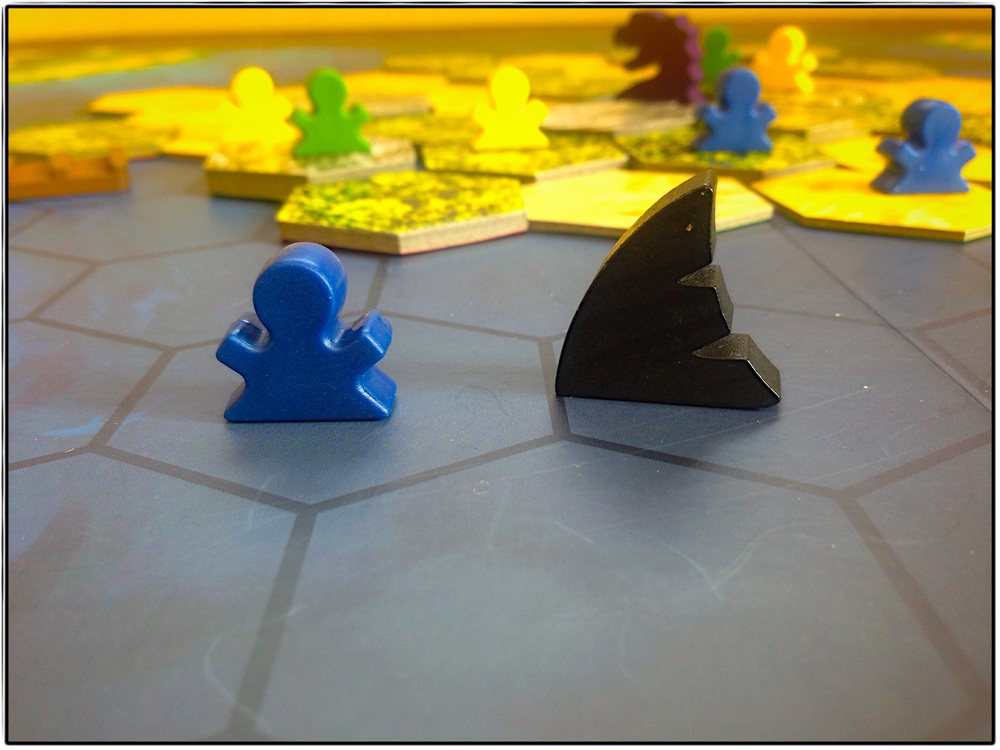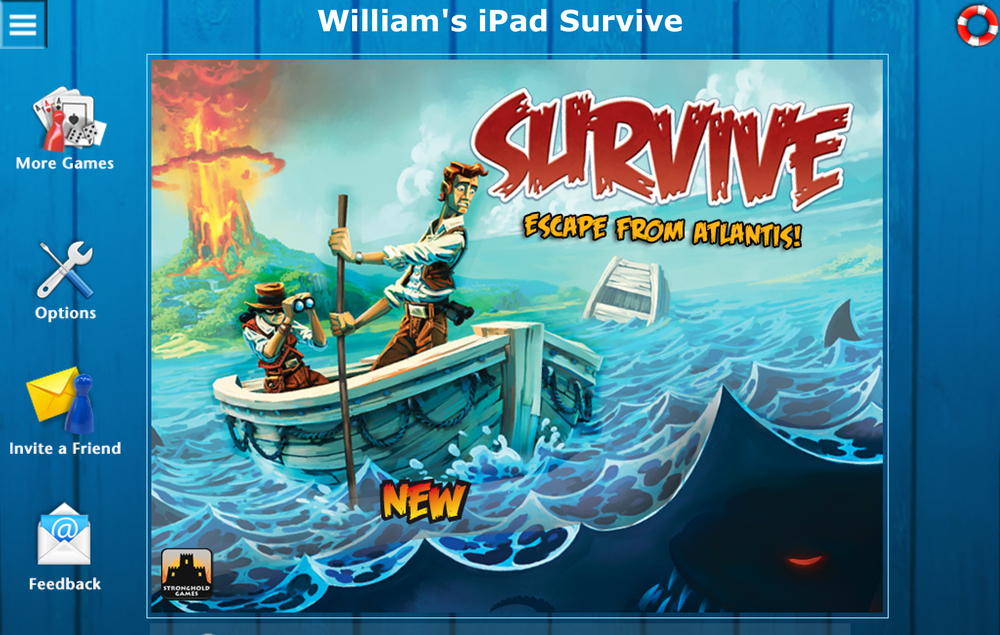
You’re on an island that’s sinking beneath your feet. Jungle, stone and sand are being consumed by the hungry ocean. Only a few rowboats stand between you and freedom on stable, neighboring islands. Rowboats and sharks. And whales. And giant sea serpents.
Did I mention the neighboring explorers who are trying to commandeer your boats?
This week we’re looking at Survive: Escape From Atlantis from Stronghold Games, comparing the tabletop version and the iPad version. Survive is a family-friendly competitive game for three to four players ages eight and up. It takes about 45 minutes to play.
Survive has been a staple in my home for a couple of years now, and I was eager to try the iOS version when it was released. Spoiler: It’s really disappointing. But let’s start by focusing on the good. First, Survive for the tabletop.
Survive: Escape from Atlantis at the table
Components
I like games with big, chunky pieces and Survive is definitely one of them. Inside the box you’ll find: * Game board. * 40 chunky cardboard terrain tiles. * 40 explorer tokens, 10 of each color. Basically plastic meeple. * 5 sea serpent tokens * 6 shark tokens * 5 whale tokens * 12 ship tokens * 1 creature die * The rulebook
The components aren’t the most gorgeous I’ve ever played with, but they fit the theme and are substantial enough that they’re fun to play with. My favorites are the purple sea serpents. They just look so mean.
Game play

To begin, the tiles are randomly placed within the highlighted area on the board. Next the sea serpents are placed in designated areas and each player takes two boats. Lastly, players place their survivors on the island, where ever they choose. Then it’s time to play.
On your turn, you must complete three actions in the following order:
1. Play a tile from your hand.
2. Move your explorers/boats.
3. Remove a terrain tile.
4. Roll the dice to move a creature.
Note that for action number two, you have three movement points to spend. That is to say, you can move an explorer one space and a boat two, a boat three spaces, three explorers one space each, and so on. Any combination you can think of, as long as you don’t exceed three movements.
Next, you remove a tile from the island and it sinks a bit further into the sea. There’s an event on the bottom of each tile. Some of them happen right away. For example, a shark might appear in that spot, or perhaps you get to relocate a sea serpent. Other tiles are held until you want to use them (action one above), like the shark repellant.
Finally, roll the die to move a creature. Remember those competing explorers who are trying to escape? Here’s your chance to sic a shark on them.
The Survive experience
There’s an enjoyable tension when lifting a tile, and placing a monster is its own fun. Slow-moving boat races to the finish are also kind of hilarious, as they move just three spaces at a time. There’s also a little “take that,” as you can send sharks, whales and sea serpents after your opponents, but not so much that it’ll turn off younger players. All an all, I quite like Survive on the tabletop.
On the iPad, it’s a different experience entirely.
Survive on the iPad
Survive: Escape from Atlantis for iPad ($2.99) faithfully reproduces the rules and turn-taking of the tabletop version, but the spirit and the fun are absent.
Two ways to play

Survive for iPad lets you either host a game with other devices that have the app installed, or play against the AI. Unfortunately, the app’s splash screen makes it look like only Bluetooth play is available and I saw several App Store comments complaining about the “lack of solo play.” It’s there, I assure you, but it’s not easy to find.
Nor is it any good.
Solo play
To play against AI opponents, you must click “Host a Game.” From there, a game creation screen that looks like it was whipped together over a lunch break lets you add local players or “bots,” or AI players. The bots are referred to as “Q1,” “Q2,” etc. I don’t know why.
At last we get to the game board. The island is randomly generated and the sea serpents are in place. To place your explorers, tap “Add explorers” and drag them to your desired positions on the island. Now it’s time to play.

There’s so much that’s bad here. The computer players’ turns happen so quickly that is difficult to know what even happened. They’ll play a tile, spend their three movement points, flip and tile and roll the dice in what felt like less than two seconds. Gathering tiles is confusing, too. When you lift a tile, it simply disappears and offers no indication of what’s on the other side. You must tap “show tiles” to see that. A simple flip animation here would be great.
There are responsiveness problems, too. Often I must tap and drag on a game piece three or four times before the game recognizes that’s what I’m doing. Game play tips commandeer nearly half the screen and, despite my tapping the button to dismiss them, keep coming back.
Add to this frustration the fact that the game is ugly and look way out of date. The icons for Options, Feedback, etc. look straight out of 1999.
Survive for iPad via Bluetooth
I couldn’t get a connection to last for more than a few minutes. So I was unable to test this.
Conclusion

Survive: Escape from Atlantis is a family-friendly, cooperative game with just enough strategy, “gotcha” moments and nice-looking components to make it a winner. Add it to your tabletop collection.
The iOS version is to be avoided at all costs. What’s more, it hasn’t been updated since June 2014, so I don’t have much hope for it.
